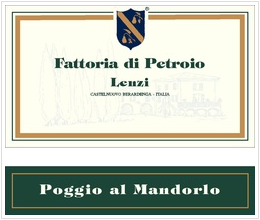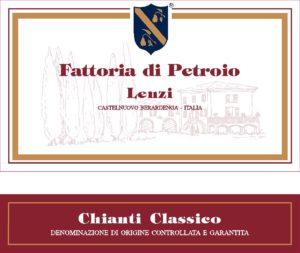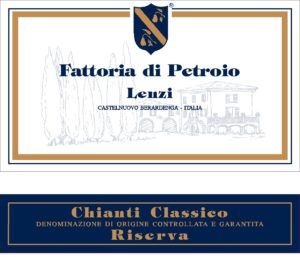
Chianti Gran Selezione – Poggio ai Grilli
| Country | Italy |
|---|---|
| Region | Tuscany |
| Producer | Fattoria di Petroio |
| Size | 750mL |
| Style | Red |
| Practices | Certified Organic, Organic |
| Grapes | Sangiovese |
| Other Features | Vegan |
Diana Lenzi is a proud producer of Chianti Classico from Berardenga, the communal district in which Petroio is located. In 2015, an association of producers called Classico Berardenga was started, including large wineries like Felsina and San Felice as well as very small ones. They all count the same: one head, one vote. They have a Classico Berardenga stand at Vinitaly, which represents all of them and where 9 wineries work side by side to promote their wines and the uniqueness of the terroir. They produce the only true Sienese Chianti Classicos.
This is a 100% Sangiovese, fermented for 15 days, with 4 months in tonneaux with bâtonnage. It is aged 12 months in tonneaux and 12 months in the 22,50hl “Pamela 50” barrel. Intense nose of red ripe fruits: cherries, black cherries and currants. A sweet note brings back to spices and flavors of cooked fruits, with a more herbaceous and minty background. Great depth and very complex, it will need a few years to express its full potential and structure. Full, velvety palate. The young and bright tannins will mellow after longer aging. Bottled June 2018. 3000/750ml bottles; 100/1500ml bottles; 25/3000ml bottles; 40/5000ml bottles.
In Diana’s own words: “in 2013 the Consorzio del Chianti Classico introduced a new type of wine: the Gran Selezione. They aimed to elevate the production and exalt Sangiovese from Chianti Classico. The debate was very animated and I thought the rules were not precise enough to truly express and guarantee a totally “Grand” product. At Petroio all these rules were already employed for our Riserva, which was the true punta di diamante (diamond tip) of our cuvées. I decided that I would not produce the Gran Selezione until I had something truly different to offer.
When the first day of harvest 2015 arrived, we were all blown away by how beautiful the ripe healthy grapes were. After a few tough vintages, we had a wonderful growing season, with just the right amount of sun, warmth, and rain to make the vineyards thrive. My team and I stood around our sorting table, looking at the grapes, and failing to find anything to throw away. Knowing how picky we all are, it was a real miracle. Every so often that first morning, one of us would pick up a grape and show it off to the others: “look at this one!” and “did you see this one??” and “have you ever seen anything like this?”.
That is when the idea hit. We decided we would pick the absolutely best grapes the next morning. We wanted to do a single barrel of the five star, belli belli belli belli belli grapes. I woke up the next morning at 6am, full of excitement and energy, with the typical broken back of harvest day two. I took my dog, Maribò, for her morning walk and stopped to stretch. That is exactly when this picture was taken.
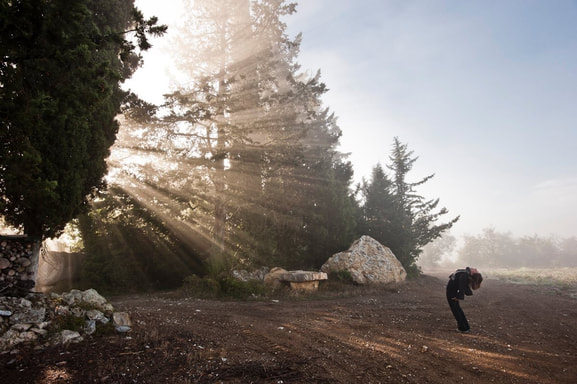
We spent the morning in the Vigna del Viale vineyard, 100% Sangiovese planted in 2008. We brought back about 15 bins (3000kgs) of grapes to the cellar that we crushed and put in a 40hl barrel. Spontaneous fermentation happened and we kept the must on the skins for 20 days. As we ran around the cellar like crazy people in one of the most abundant and bountiful harvests we can remember, we treated the barrel as our golden child. In December, we moved the wine to our 22.5hl “Pamela” barrel (named after my mother), and left it to age for almost 30 months. During that long period, we constantly watched over our special wine.
We named the wine Poggio ai Grilli, in honor of a historic vineyard at the heart of our winery, with 60 year-old vines we were in the process of replanting via massal selection. For the label, we sought something representative of the vineyard, our work, and the uniqueness of the story behind this wine, maybe also the fatigue of it. That fatigue was exactly what lead us back to this photo, taken that morning during harvest, right before the wine was about to come to life. It all made sense.”
The 2015 Fattoria di Petroio Poggio ai Grilli Chianti Classico Gran Selezione went on to score a 95 in Wine Enthusiast, a 97 in Decanter and a Platinum Medal at the Decanter World Wine Awards.
About the Producer
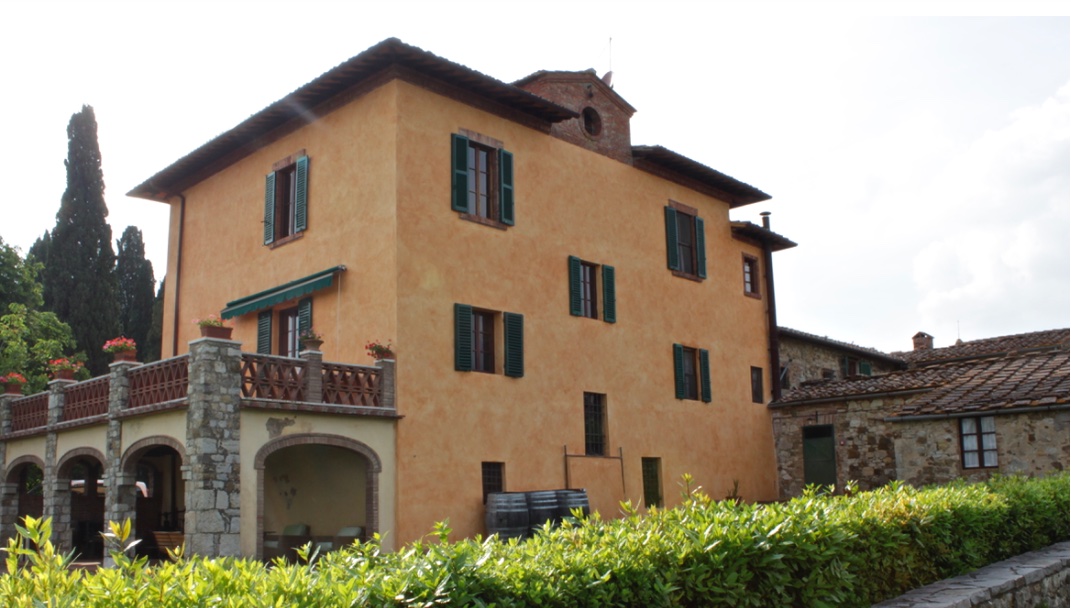
Fattoria Petroio lies in the heart of Chianti Classico, midway between Castellina and Siena in the hamlet of Quercegrossa. They are neighbors of the Fonterutoli estate, to whom they sold 15 HA of vine-plantable land in the early 2000s. The history of the settlement of Petroio goes back to the times of the ancient Romans as may still be seen in the ancient “opus reticulatum” wall incorporated into a farm house near the main cellar. The paved road that passes right in front of the main villa is a remnant of the ancient medieval road connecting Siena and Florence, which passed through the Chianti territory. It leads toward a small church dating back to the early 11th century and dedicated to St. Michael the Archangel. The Lenzi family currently leases the chapel from the Curia in Siena and recently completed its restoration. Once a year, on Ascension Day, a Mass is said that is open to all the people from the village, followed by a ‘Fiesta’ with buffet (which the owners prepare and serve) and traditional music and dancing on the old threshing floor in front of the wine cellars. The name Petroio comes from “Pietra” which means “stone." All the buildings were made from local stone and traditionally white washed every 2 to 3 years. In recent years they have been restored to show the stones and the wood beamed ceilings.
The Petroio estate has been in the Pallini-Lenzi family since circa 1886. The actual owner, Gian Luigi Lenzi, inherited it from his grandfather Luigi Pallini II in 1961. The entire property was originally over 160 hectares of woods, vineyards and olive groves. It now occupies 100 hectares, including 15 hectares of vineyards. Thanks to Pamela, Luigi's wife, the already existing wine production was given a shot of new energy, enthusiasm, lots of hard work and heavy investments in both the vineyards and cellars, which eventually transformed the existing rural farm into a renewed, modern high quality winery.
The Lenzi family started restoring the estate in 1980 with the help of the now renowned consulting oenologist Carlo Ferrini (WS Winemaker of the Year), who at that time was working for the Consorzio del Chianti Classico, and as an inspector gave free advice to members. He remained with the Lenzis to this day, even after leaving the Consorzio. The old family estate had 5000 white vines, so in 1983 Carlo had them hand-grafted to Sangiovese and Colorino vines; only four vines did not take! The Lenzi’s always took great pride in their clones of Sangiovese - newer clones with thinner skin, and never gave into planting international varieties.
Diana Lenzi, Gian Luigi and Pamela’s daughter, currently runs the estate with dedication, energy, and passion. Born and raised in Rome, Diana graduated in Political Science and trained as a chef - getting a diploma from the professional school of Gambero Rosso - before taking on the management of the family winery in 2008.
" When my father asked me to take over the family winery, and drop my dream job as a chef in Rome, my mouth instantly said yes, but my heart and head crumbled. It was a huge leap and I understood that the only way I could make it, and maintain our family legacy, was by doing it my way. Fortunately, I was already blessed with the understanding that anything we eat or drink can evoke an emotion only if it starts with a great initial ingredient, and the ingredient which was going to be my focus now was Sangiovese. That was in 2008 and the results have been remarkable. My journey started in the vineyard and segued to the cellar. I went from ownership to hands-on management and wine making."
Diana's dedication to making the highest quality wine possible led her to rip out all the vines she felt were inferior varieties for her terroir. In 2015, she planted three hectares of vineyards which came from a clone selection that lasted three years: “In fact we used the last vineyard from the 1960’s and selected Sangiovese Canaiolo, Colorino, black Malvasia, as well as white Malvasia and Trebbiano. Almost 70% of the cuttings came from our selection.” Professor of the Master in Food and Beverage Management and of the Online Master in Agribusiness Management, Diana was between 2021 and 2023 president of CEJA, the Organization of Young European Farmers which brings together 30 agricultural associations and two million EU producers.
Farming/vinification practices: 2015 was the first fully organic vintage. The grapes are hand-harvested, put in small plastic bins, sorted and gently pressed. The varieties are vinified separately in glass lined cement tanks. Petroio has been using indigenous yeasts since 2015, except for the 2017 vintage which was way too hot. Pumping over is done for 8 to 10 days, three times a day, depending on the vintage. The barrels (500 liter Allier noisette barrels from Sylvain and Nadalie) are seasoned with hot water before they are used for wine. In the spring following the harvest, Ilaria Marcomini and Alessio Petrucci, together with Diana Lenzi and Carlo Ferrini, select which wine will go in the Normale and which will be blended and set aside to age as the Riserva. The wines are vegan. The yearly production averages 45,000 bottles.
“Petroio is not just vineyards, vines, olive groves, wine and olive oil. Petroio is also 247 acres of woodlands dedicated to the repopulation and preservation of the local fauna. Petroio is not, therefore, just the Lenzi family Villa at the end of the cypress drive but innumerable deers, foxes, porcupines, wild boars, hares, pheasants and many other local bird varieties that, among the tall trees and shrub, find refuge from the nearby expanding town, the cars speeding by on the once gravel road, and the local hunters now radio connected during their hunting."
Notes on the discussed new classification:
The Consorzio has not yet made a decision regarding the subzones of Chianti Classico, but Diana Lenzi firmly believes there is a very distinctive character of soil and terroir in each of these areas. She is a proud producer of Chianti Classico from Berardenga, the communal district in which Petroio is located. In 2015, an association of producers called Classico Berardenga was started, including large wineries like Felsina and San Felice as well as very small ones. They all count the same: one head, one vote. They have a Classico Berardenga stand at Vinitaly, which represents all of them and where 9 wineries work side by side to promote their wines and the uniqueness of the terroir. They produce the only true Sienese Chianti Classicos.
Fattoria di Petroio

related products
-
Fattoria di Petroio
Toscana Rosso – Poggio al Mandorlo
-
Fattoria di Petroio
Chianti Classico
-
Fattoria di Petroio
Chianti Classico Riserva

